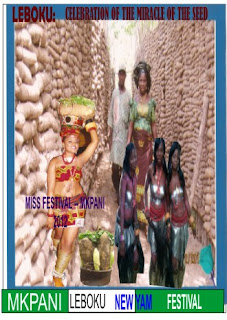MKPANI LEBOKU NEW YAM FESTIVAL
HISTORICAL PERSPECTIVE:
Mkpani new yam festival is a traditional celebration of thanksgiving to God, for increased fertility in birth rate, increased production of food (new yam) and peace and unity of the community. Mkpani people like all Yakurr people, and indeed, all humanity, love and strive for the gift of children, enough food to feed them and the peace and unity of their community. Mkpani people believed that these dire needs of every human society are provided by almighty God, who deserves thanks. This is why they have to set aside a period for a traditional thanksgiving to God every year for the continuous provision of these dire needs.
In Yakurr, every year is alternated with a period of plenty and a period of scarcity or famine. After farms have been planted between the period of January and May, farmers subsist on meager reserve of food. These reserves may be adequate or inadequate, depending on the status of the farmer. In the months of June, July and August, sometimes families who reserves are meager, actually live on the brink of starvation, especially those who do not have money to buy food.
In consequences, most of the farmers are full of dreamy expectation or anxieties about the outcome of their harvest of new yams. The traditional rulers are usually the first to harvest from a small traditional farm, which was cleared, cleaned, tilled and planted with yams called “Lise Temy”. When they harvest the yam, they will prepare a pounded yam meal, which they will eat with relish and thanksgiving to God for the gift of the new yams.
This ceremonial eating of the new yam by the traditional rulers will now be announced publicly, and all farmers will be free to make test harvest of their new yams. This ritual could be compared with. “The festival of the pumpkin leaves” in Chinua Achebe`s “Arrow of God.” The chief priest of the new yam festival and traditional rulers (Yanun Usor) will now begin to make traditional arrangements to announce the date of the new yam festival.
The announcement of the new yam festival traditionally ushers in a period of peace, high expectation of joy and thankfulness to God almighty, who traditionally is being approached through the traditional fertility god. This approach to the almighty God, through a traditional medium, has been the distinguishing character of the Africa religion, which considers the Almighty God, too holy and great to be approach directly by man. Christians are now working hard to change this absurd philosophy of the Africa religion, by informing people that the almighty God, the provider of all good things, could be approach directly.
From the day of the announcement of the festival, the Chief priest of the festival and the traditional rulers (Yanun Usor) will decree against quarrelling, fighting, playing of cultural dances and any act that might breach the expected peace in the community. On the other hand, hunters, tap setters, palm wine tappers and other trade men will be encouraged to take their professions seriously so that everything will be in abundant supply during the feast.
The new yam festival is celebrated primarily in two days. The first day is called the women day. People will remember all their dead relations who are women and will make a ritual spiritual union with them at their grave sites. In the night of the first day, the midnight fire will be lit at the three major playground of the town. The fire which is made of fire wood is made to provide natural light for the ritual rites. Now members are not allowed to see how this fire is lit; only the initiates are guaranteed access. Prior to the dawn of the first day, the three symbols of the new yam festival will be displayed in the three major playgrounds.
These three symbols are:
1. The white band of cloth; which symbolizes purity
2. The coconut fruit coated with native chalk: which symbolizes peaceful fertility and
3. The bowl of native chalk: which symbolizes peace.
These three objects and what they symbolize sum up the sacred essence of the new yam festival. The new yam festival therefore, is a traditional thanksgiving to God. For the fertility of women and increase birth rate, the purity of life and peace in the community.
Before the traditional Ekoi dancers begin their dance, the traditional rulers will parade in their Chieftaincy regalia across the arena. The royal father`s precession is always led by the Okpebri of Mkpani, the war Chief, who by the Mkpani traditions is the mouthpiece of Obol Lopon, who is the monarch of the community. After the Okpebri, the two Yanun -Ekor will lead their overlord monarchs. That of Afaben will be in front of Obol Lopon of Mkpani, while that of Aduma will lead the Aduma manarch.
Then, Bina will follow in their order of seniority. It should be noted that Bina like Obol Lopon, are family shrine heads. They all are representing their maternal families as family shrine chiefs, and Obol Lopon is enjoying the status of Primus Interparis first among the equals.




Comments
Post a Comment